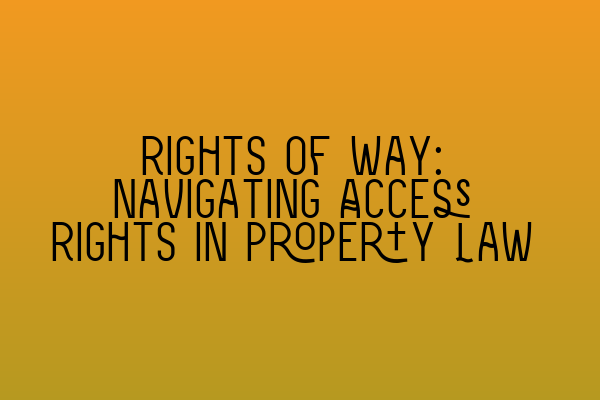Rights of Way: Navigating Access Rights in Property Law
When it comes to property law, understanding your rights and obligations is crucial for a smooth and hassle-free ownership experience. One important aspect of property law is the concept of rights of way, which determines the legal right to access and use a particular piece of land. In this article, we will explore the intricacies of rights of way and how they affect property owners and users.
What are Rights of Way?
Rights of way refer to the legal permission granted to individuals or entities to access and pass over another person’s land. These rights are typically created through legal agreements or by long-standing usage over time. They enable landlocked properties to have access to public roads, or they can provide access to specific areas within a property.
There are different types of rights of way, including public rights of way and private rights of way. Public rights of way are typically established by law and allow the general public to access certain routes, such as footpaths, bridleways, or highways. Private rights of way, on the other hand, are granted to specific individuals or entities, usually for their benefit or for the benefit of their property.
Establishing Rights of Way
Rights of way can be established in various ways, and their existence may not always be immediately apparent. Here are some common methods by which rights of way can be created:
- Express Grant: A right of way can be created explicitly through a legal agreement, such as a deed or a contract.
- Prior Use: If a particular route has been consistently used for a long period of time without interruption, it may be argued that an implied right of way has been established.
- Necessity: In certain circumstances, a right of way may be granted out of necessity, such as when a property is landlocked and requires access to a public road.
- Prescription: Similar to prior use, a right of way can be established through prescription, which requires the continuous and uninterrupted use of a route for a specific period of time, typically 20 years.
Resolving Disputes
Disputes regarding rights of way can arise when there is uncertainty or disagreement about the existence or scope of a right. It is essential to have a clear understanding of your rights and obligations in order to avoid potential conflicts. If a dispute does arise, it is often best to seek professional legal advice to resolve the matter.
SQE Property Law & Land Law has extensive experience in handling rights of way disputes. Our team of solicitors is skilled in navigating the complex legal landscape and can provide expert guidance tailored to your specific situation.
Protecting Your Rights
If you believe you have a right of way or wish to establish one, it is important to take steps to protect and maintain that right. Here are some actions you can consider:
- Documentation: Ensure that any rights of way granted to you are documented properly in legal agreements, such as deeds or contracts.
- Maintenance: Regularly maintain the route over which the right of way exists to demonstrate its continuous use.
- Notification: Notify any new owners or tenants of your property about the existence and extent of your right of way.
Conclusion
Rights of way play a crucial role in property law, providing necessary access to land-locked properties and enabling individuals to exercise their rights as property owners. Whether you are seeking to establish a right of way or resolve a dispute, it is important to seek professional legal advice to ensure your rights are protected.
At SQE Property Law & Land Law, we are dedicated to providing comprehensive and expert legal services to our clients. Contact us today to learn more about how we can assist you with your rights of way matters.
Related Articles:
- SQE Contract Law: Analyzing Landmark Cases and Influential Judicial Decisions
- Understanding Contractual Capacity: Rights and Limitations
- Interactive SQE Mock Tests for Contract Law: Test Your Knowledge
- Join Our SQE Contract Law Webinars: Expert Insights and Guidance
- SQE Prep: Mastering the Essentials of Contract Law
